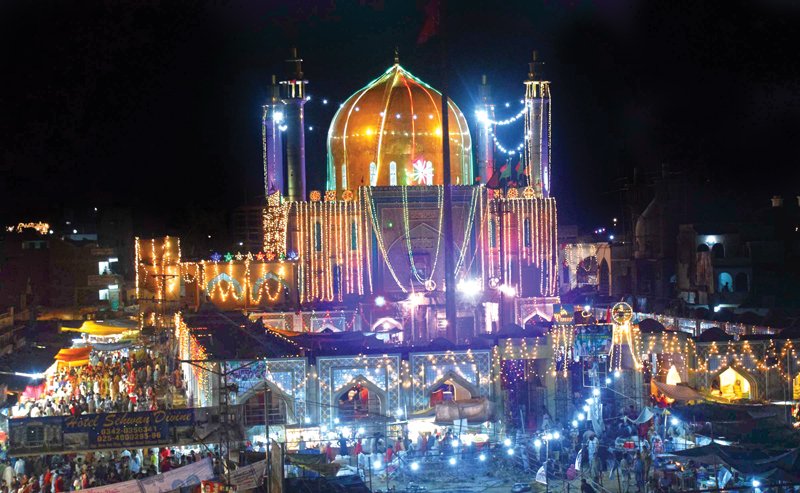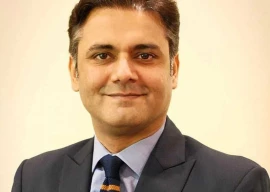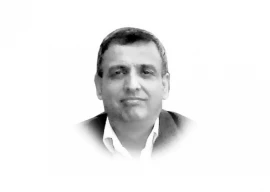
The small town of the Jamshoro district, located on the foothills of the Khirthar mountains around 146 kilometres off Hyderabad, welcomed hundreds of thousands of devotees at Qalandar’s 762nd urs.
For people like 48-year-old Nazar Muhammad, a resident of Multan, attending the annual urs is akin to a religious obligation. “I have never missed the urs since my youth, except for the two times when I was very sick and I still feel guilt for them,” he told The Express Tribune as he loses himself to the tunes of the Qalandari dhamal.
The devotional dance, performed on the beats of dhol and naqqara, two traditional percussion instruments, is a regular attraction in the shrine’s courtyard. For the devotees, watching and participating in the dhamaal are part of the rituals, and the courtyard is soon filled.
“We start dancing when we feel an urge to do it. It begins voluntarily but it often takes over. Sometimes it takes seconds and sometimes minutes,” said the elderly Fakir Gul Sher, who claims that he has been living in the shrine for over two decades now. According to him, the devotees also dance when their wishes come true.
At the Shahbaz Adabi [literary] conference organised on Wednesday night, the speakers called for academic research on dhamaal. “It’s regrettable that dhamaal hasn’t been the subject of any meaningful research, unlike the whirling dance at Maulana Rumi’s shrine,” said Dr Nawaz Ali Shauq while speaking at the conference.
The movements in the dance have a symbolic meaning connected with divinity, he said. “On the face of it, the dance seems like someone is falling into a trance. But spiritually, it is a way to connect you with the divine, and emotionally it has a relieving effect.”
Lal Shahbaz Qalandar and the urs
According to historian Nazar Hayat, Qalandar went to Iraq and Iran from Arabia before coming to Sindh in the 13th century. Hayat highlighted the need to conduct research on Qalandar’s life, pointing out that the saint is not mentioned in the writings of his contemporaries.
Over the last seven centuries, disciples and followers of Qalandar from across Pakistan and India have been revering the saint. According to the shrine’s caretaker, Syed Hajan Shah Lakyari, each year they witness an increase in the number of devotees who flock the small town during the urs, where traditional wrestling, horse racing, agricultural and industrial exhibitions, and musical nights are additional attractions. According to unofficial estimates, between 500,000 to 700,000 people attended the urs this year.
However, the provision of facilities such as accommodation, water and transport remain dismal. The shrine’s beautification and expansion works, for which the provincial government earmarked Rs1.25 billion, are still far from completion.
The deaths
As many as 54 deaths have been recorded in Sehwan during the four-day urs, with 10 being reported on Thursday. Except for a few who drowned while swimming in the water channels, almost all others died due to the heat stroke, with temperatures reaching 47 degrees.
Prolonged power outages in the heat caused suffocation in the shrine and the narrow streets that surround it and a lack of clean drinking water and inter-town transport made matters worse. Sindh United Party’s leader, Roshan Buriro, who led a protest against the government for failing to provide better facilities, blamed the government for the loss of lives.
“The criminal negligence of the government is responsible for these deaths,” he said. “We are going to take the matter to court.”
However, Sindh Chief Minister Syed Qaim Ali Shah, who spoke during the closing ceremony of the urs, acknowledged that dozens of devotees have died but maintained that their deaths were caused by the extreme heat and could not have been prevented. “I will take action against the district administration of Jamshoro if I receive any complaints,” said Shah.
Published in The Express Tribune, June 20th, 2014.
COMMENTS (4)
Comments are moderated and generally will be posted if they are on-topic and not abusive.
For more information, please see our Comments FAQ




































1714370039-0/ojwilson-(1)1714370039-0-270x192.webp)


-(1)1714378140-0/AliAminMaryam-(4)-(1)1714378140-0-270x192.webp)
-(1)1714458896-0/ASP-(2)-(1)1714458896-0-270x192.webp)






@Haris Chaudhry: Talking about throwing blame, the media didn't even highlighted the said issue as it should have, be it against the provincial government or the federal. Having said that you can not justify any unnatural death with that of the natural calamity.
What happened in Sehwan was government brutality, In your given perspective if the death of 54 people of the said region is not even comparable to that of the 08 deaths in Lahore, then you my friend have a problem and its called ''Ignorance''.
How regrettable and unfortunate Model Colony tragedy may be, but the barbarism portrayed in the name of police brutality or the government incompetency in saving precious lives of the people should be condemned in whatsoever means. If not, then it might be assumed from your statement that the life of people hailing from takht-e-lahore is superior to than that of the rest.
Crazy Stuff ! Right ?
Aww geez. Qalandar-- the word itself is so romantic - like straight out of the Arabian Nights .
@ Aqib Ali Shah:
10,000+ people die every day in USA out of natural causes ! The media does not go "GA GA" over it nor does it has to - Same in every country of the world !
What happened in lahore was police brutality for which media has to go "GA GA" as it is out of ordinary and should be condemnable.
500,000 people congregated in 48 degree heat in a place with not enough facilities and 40 of them died due to heat strokes. No body killed them except the nature.
Sometimes, the 'posters' just need to understand the context and be reasonable before throwing accusations at media for simply reporting stuff...
Crazy stuff !
When 08 people died in lahore, Punjab the whole media went gaga over it- while more than 60 people died in Sindh, nobody paid heed to it. Irony. Shame on PM and Shame on CM Sindh.